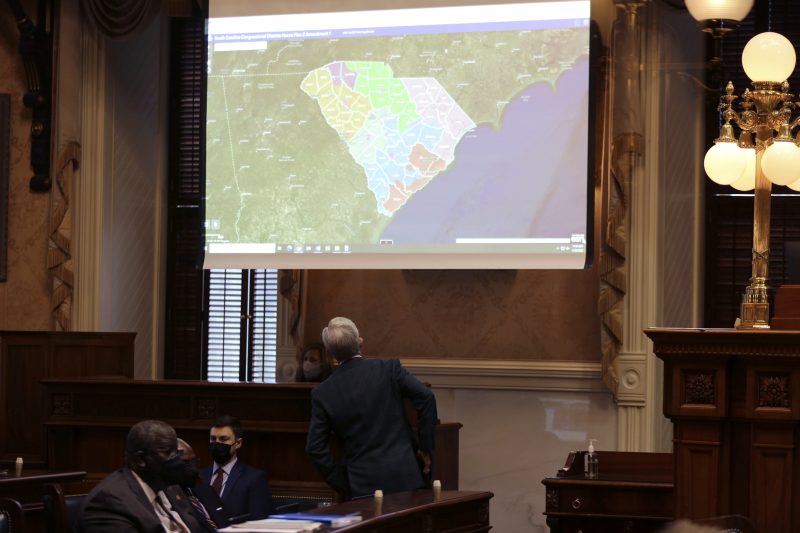In a scenario that has played out in three states in recent years, a federal court ruled Thursday that time had run out to draw a new congressional district in South Carolina and that the state would have to proceed this fall with an existing election map the court had previously deemed illegal.
The ruling echoes redistricting cases in other Southern states where courts found that congressional maps violated the voting rights of Black voters and other people of color but allowed them to be used anyway, at least temporarily. In recent years, that happened in Alabama, Georgia and Louisiana.
In the latest instance, a panel of three judges decided to let South Carolina use a new map drawn by the Republican-led legislature because the Supreme Court had not yet decided an appeal that will ultimately determine how the district should be drawn. Voting rights advocates decried the ruling, saying it’s unjust to hold even one election in districts that are unconstitutional.
“Once an election happens, you kind of can’t get back that election,” said Leah Aden, senior counsel for the NAACP Legal Defense Fund, which brought the South Carolina lawsuit.
The ruling came a day after a different federal court upheld a congressional map in Florida that favors Republicans and erases a seat held by a Black Democrat. Those decisions, along with others in recent months, mean the congressional maps for 2024 are largely set. Republicans narrowly control the House, and voters this fall will decide whether to let them keep it.
Also Thursday, a federal appeals court issued a ruling that all but ensures North Carolina will use state legislative maps this fall that Democrats and voting rights advocates say dilute Black representation in the statehouse.
Michael Li, senior counsel for the Brennan Center’s Democracy Program, said appeals take so long that states sometimes get a chance to use illegal maps for one or two election cycles before they are forced to draw new ones.
“It’s becoming more common,” he said. “Courts used to go out of their way to have voters not vote on a map that had been deemed illegal. Now, unless you get everything resolved, you have to vote on a map that is illegal. The courts can undermine voters’ rights through the process.”
Last year, a panel of three judges concluded that South Carolina’s Republican-led legislature “exiled” 30,000 Black voters from the state’s 1st Congressional District to make it safer for a White GOP incumbent, Rep. Nancy Mace.
South Carolina appealed, and both sides asked the Supreme Court to expedite the case to ensure a final ruling was in place well ahead of election season. The justices heard arguments in October but have yet to rule. At the time, a majority of the justices signaled they were inclined to allow the state to use the boundaries drawn by lawmakers.
With no decision and the June 11 primary on the horizon, South Carolina sought permission to use the map this year even though it had been deemed unconstitutional. The panel of judges unanimously agreed Thursday to keep the map in place for this election.
It noted that courts typically don’t allow maps to be used once they have been found to be invalid. “But with the primary election procedures rapidly approaching, the appeal before the Supreme Court still pending, and no remedial plan in place, the ideal must bend to the practical,” the judges wrote.
If the Supreme Court reverses the lower court ruling later this year, the district will remain as is through 2030. If it upholds the lower court ruling, new maps will have to be drawn for the 2026 election.
Last year, the Supreme Court upheld a decision that found Alabama had violated the Voting Rights Act and had to draw a new district. Voting rights advocates hailed the decision but expressed frustration over how long the case took, noting the Supreme Court had allowed the 2022 elections to occur using district lines that a court had deemed illegal.
“Being timed out is very disappointing for any voting rights plaintiffs,” said Abha Khanna, the attorney who won the Alabama case. “But the light at the end of the tunnel is that there is always another election and it’s usually not far away.”
Joshua Douglas, a University of Kentucky law professor, said the South Carolina case tracked the Alabama case as well as ones in Georgia and Louisiana. “This shows how states have successfully run out the clock in election years, allowing them to use maps that courts have found illegal,” he said.
Last year the panel, which consists of two judges nominated by President Barack Obama and one by President Biden, found the map illegally split neighborhoods in the Charleston area to make Mace’s race easier. The new lines constituted a racial gerrymander that “exiled over 30,000 African American citizens from their previous district,” the panel found.
But on Thursday, with no decision from the Supreme Court, the panel determined it had to allow that map to be used this fall because there is little time left. Primary ballots must be sent to military and overseas ballots by April 27 under federal law, the judges noted.
“The district court had no choice,” said Richard L. Hasen, a UCLA law professor and director of the Safeguarding Democracy Project. “So I think really the fault here lies with the U.S. Supreme Court.”
The Supreme Court has been handling cases more slowly of late. At this point during its 2005 term, the court had decided more than half the cases in which it heard oral arguments, according to Empirical SCOTUS, which tracks court cases. This term, the court has decided just 22 percent of such cases.
In arguments before the Supreme Court in October, attorneys for South Carolina argued that state lawmakers had not relied on race to draw maps in violation of the Constitution. Rather, they used political information to help them decide where to place the lines, they said.
Colby Itkowitz and Rachel Weiner contributed to this report.







































